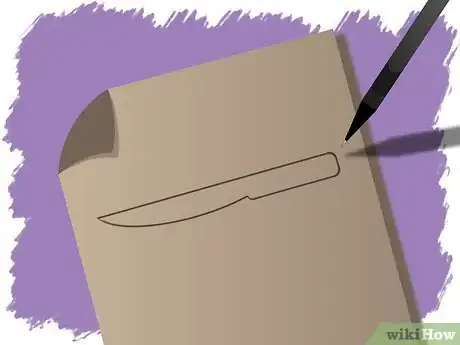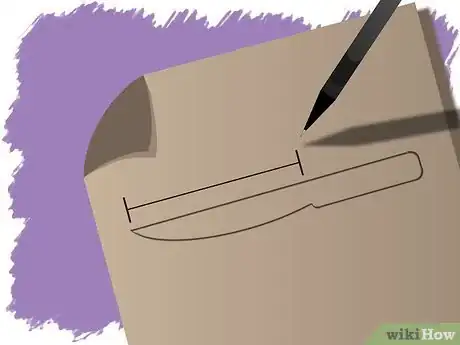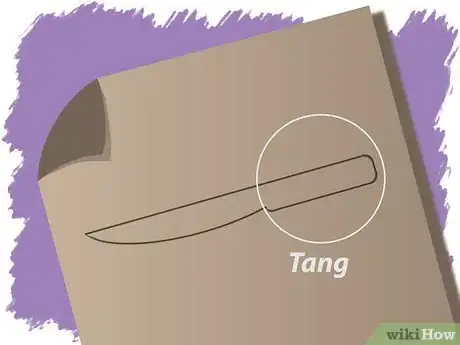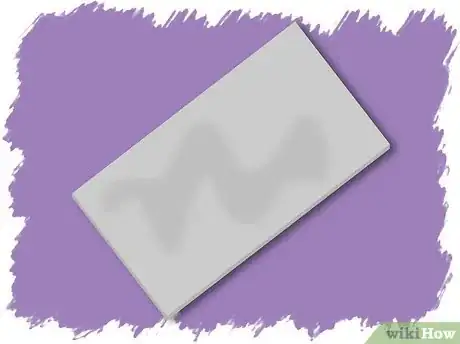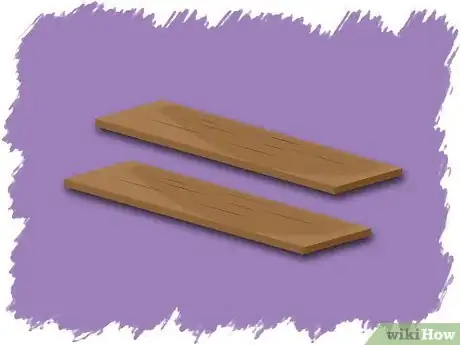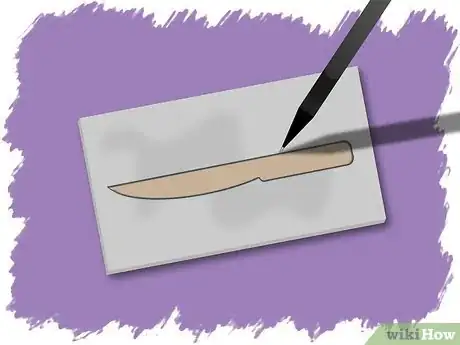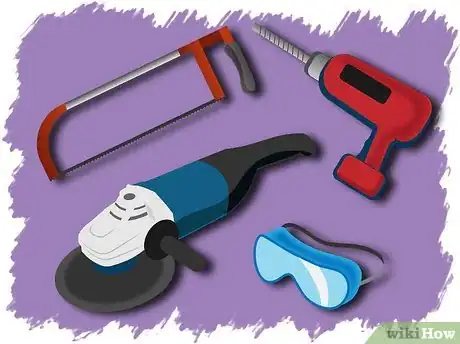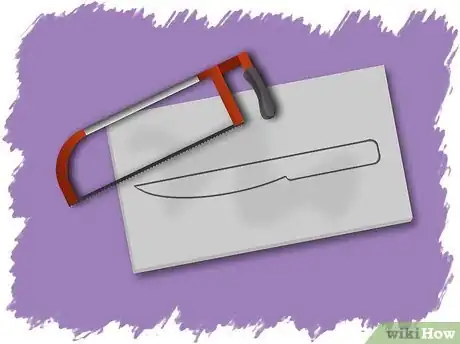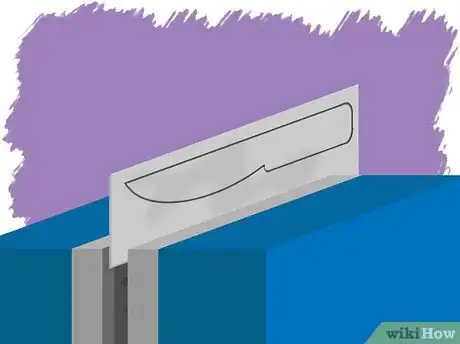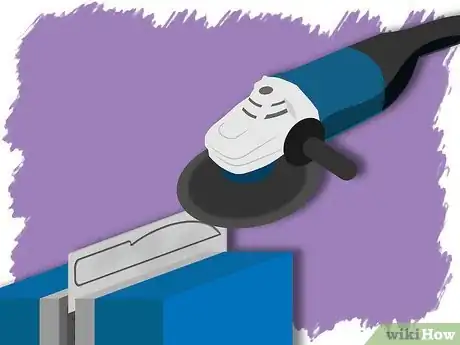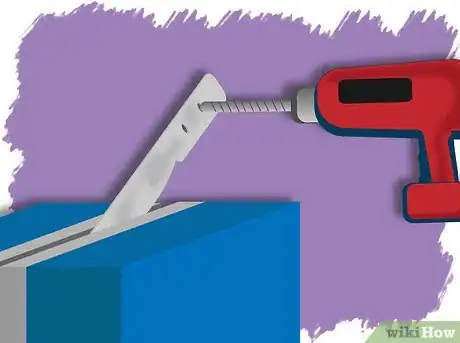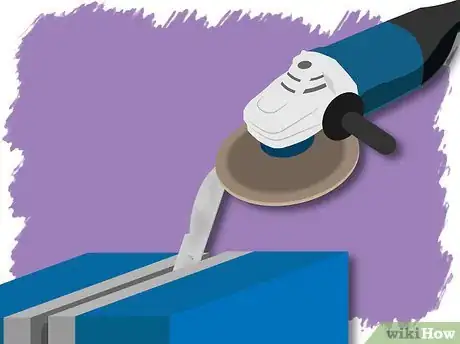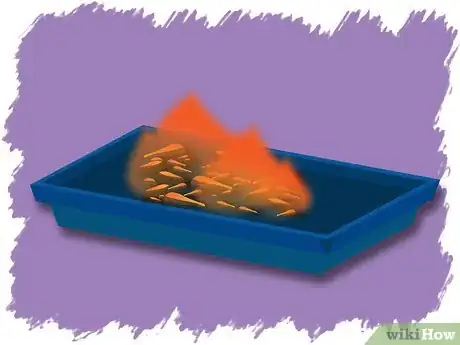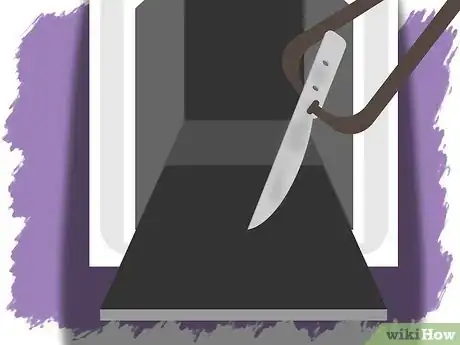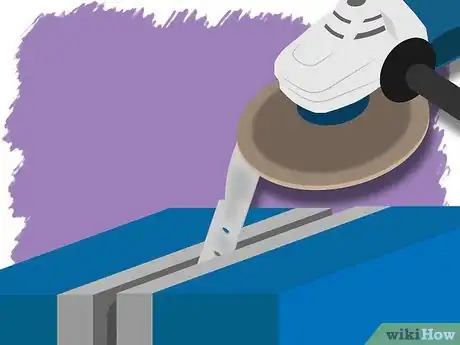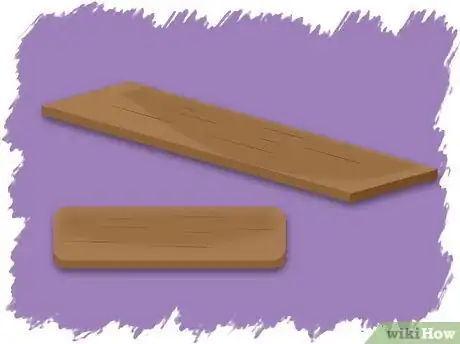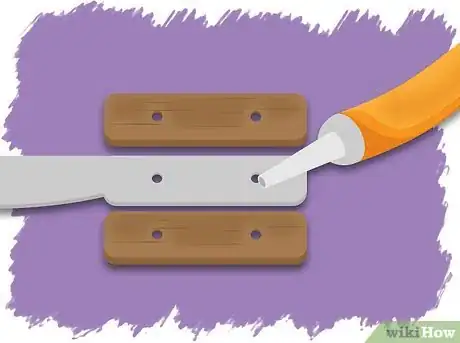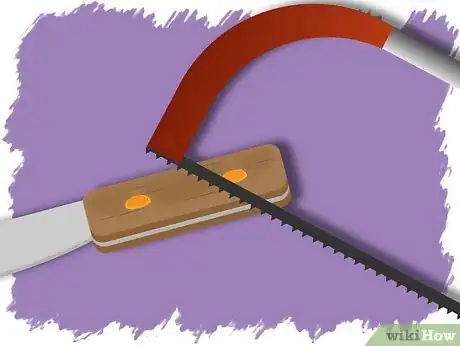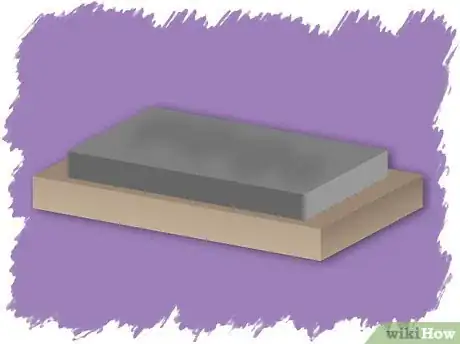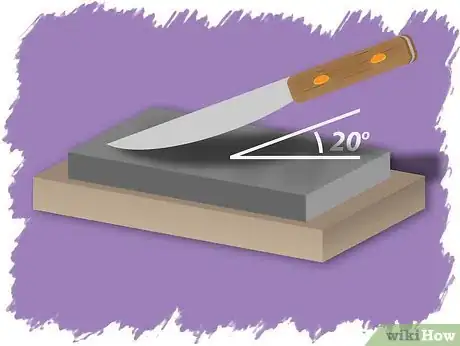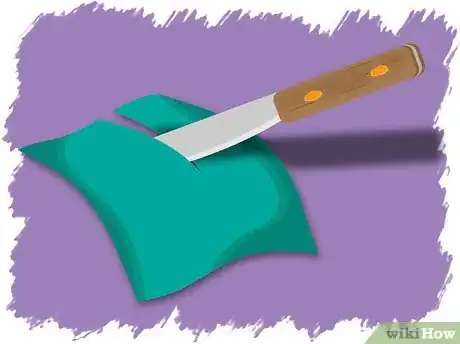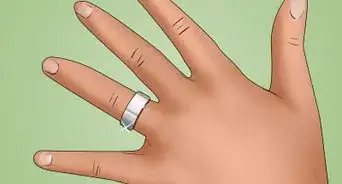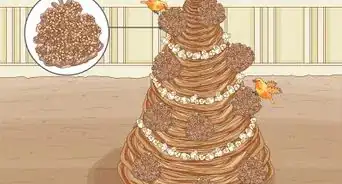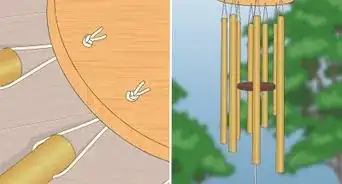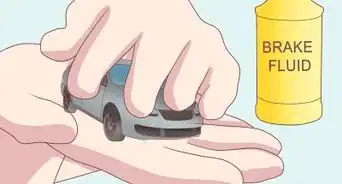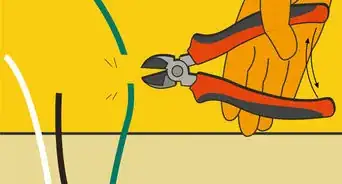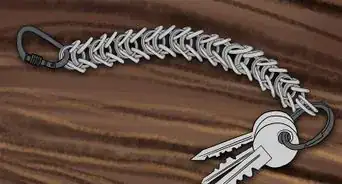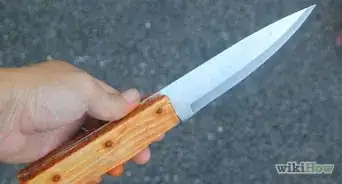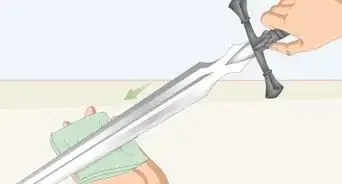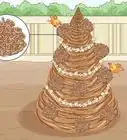X
wikiHow is a “wiki,” similar to Wikipedia, which means that many of our articles are co-written by multiple authors. To create this article, 33 people, some anonymous, worked to edit and improve it over time.
There are 11 references cited in this article, which can be found at the bottom of the page.
This article has been viewed 185,717 times.
Learn more...
Making a knife from scratch can be a fun, rewarding, and useful metalworking project. It's time-consuming and work-intensive, but if you follow these steps you'll have a brand new knife before you know it.
Steps
Part 1
Part 1 of 6:
Design the Blade
-
1Draw the blade. Use graph paper to design the shape of your blade. Try to keep it as close to actual size as possible to ease construction.
- Get creative with your blade design, but keep functionality and practicality in mind.
-
2Decide on blade length. The length of the blade is largely a personal preference, though large blades can be unwieldy and require lots of steel.Advertisement
-
3Design the tang. The tang is the piece of the blade that attaches to the handle. The easiest method is known as the “full tang.”[1] The tang will be the same thickness as the knife, and the handle is formed by attaching a piece of wood to each side with rivets.
Advertisement
Part 2
Part 2 of 6:
Gather Tools and Materials
-
1Obtain carbon steel. There are many different kinds and grades of steel.[2] Do not use stainless steel, as the metal is difficult to work with and the blade will not be as fine. 01 is a popular carbon steel for blade making because it is easy to douse when hot.
- Try to get a slab or bar between 1/8 to ¼ inch thick.
-
2Pick your handle material. Wood is an easy one to work with, though you can make a handle out of anything you would like. Since this guide is for a full tang knife, pick a material that you can attach with rivets. G10, micarta, and kirinite all are good choices and are waterproof.[3]
-
3Trace your blade. Using a permanent marker, trace your blade onto the slab. This will be the guide you use when you cut the steel. Be sure to trace the tang as well, because the blade and tang are one connected piece.
- Make adjustments to the size as necessary once you see the outline on the metal.
-
4
Advertisement
Part 3
Part 3 of 6:
Cut the Steel
-
1Use the hacksaw to cut the metal. Cut a rectangle around your traced blade to separate it from the main slab. You will need a stiffer hacksaw for thicker steel. This rectangle is what you will grind down to form the profile of the blade.[6]
-
2Grind the profile. Put the rough cut blade into a vise and grind away excess metal. Follow the guidelines to form the profile. Use the grinder to finalize the shape of the blade.
-
3Grind the edge. Gently grind the edge into a slope with the flap wheel. Make sure that the slope does not go past the middle of the blade. Make this slope on each side of the blade. Doing this forms the actual edge of the blade.[7]
- Go slowly during this step, as grinding too much can ruin the blade, forcing you to start over.
-
4Drill your rivet holes. Use a drill bit that is the same size as the rivets that you intend to use. Put the holes in the tang. Depending on the size of the blade, you may need a varying number of holes.
-
5Finish the blade. Sand the blade using successively finer grits of sandpaper, up to 220 grit. Be sure to take the time to sand out any scratches. Sand all areas of the blade. This will increase its luster and quality.
- Sand in opposite directions each time you change grits.
- You can use a file to add ridges to the inside near the handle. Trace a pattern and file the metal away.
Advertisement
Part 4
Part 4 of 6:
Heat Treat the Blade
-
1Prepare the forge. The best way to heat treat a blade is using a forge. For smaller blades, a torch can work as a substitute. For a forge, either a coal or gas forge will work.
- Prepare your hardening bath.[8] To cool the knife, you will need to douse it in a hardening bath. What you use depends on the type of steel, but for 01 you can use a bucket of motor oil. You need to be able to completely submerge the blade in the bucket.
-
2Heat the blade. Keep it heating until the metal is orange.[9] [10] Tap it against a magnet to see if it is hot enough. When the steel reaches the correct temperature, it loses its magnetic properties. Once it does not stick, let it cool by air. Repeat this process 3 times.
- On the 4th time, instead of letting it air cool, douse it in the oil bath. Be aware that there will be fire when the blade is put into the oil, so be sure that you are properly protected.
- When the blade is hardened, it can break when dropped, so handle carefully.
-
3Preheat your oven. Set your oven for 425°. Put the blade on the middle rack and cook it for 1 hour. Once that hour is up, heat treatment is complete.
-
4Sand the blade again. Use increasingly finer grits of paper, going past 220 and up to around 400 grit. Polish the blade if you want some extra shine.
Advertisement
Part 5
Part 5 of 6:
Attach the Handle
-
1Cut out your handle pieces. For a full tang knife, there are two pieces of handle, one on each side. Cut and sand the pieces at the same time to ensure that both sides are symmetrical.
-
2Attach the pieces with epoxy. Drill the holes for the rivets on each side. Avoid getting epoxy on the blade, as it can be difficult to remove. Place it in a vise and let it dry overnight.
-
3Use a saw to perform the final cuts and adjustments to the handle. Insert the rivets, leaving about an extra 1/8” sticking out each side, and peen them with a ball-peen hammer. File the rivets down and sand the handle.
Advertisement
Part 6
Part 6 of 6:
Sharpen the Blade
-
1Prepare the sharpening stone. You'll need a large sharpening stone for these steps. Lightly coat the rough side of the stone with sharpening oil.
-
2Hold the blade at a 20° angle from the surface of the sharpening stone. Push the blade across the stone in a cutting motion. Raise the handle while moving the blade to sharpen all the way to the tip. After a few strokes, flip the blade over to the other side.[11]
- After you have a sharp edge on every part of the blade, repeat the sharpening on the fine side of the sharpening stone.
-
3Test the blade. Hold a piece of printer paper in your hand and cut down near where you're holding with the knife. A properly sharpened blade should be able to easily slice the paper into ribbons.
Advertisement
Community Q&A
-
QuestionCan I use a belt grinder instead?
 Community AnswerFor making a bevel and finishing the shape of the knife, yes. I wouldn't recommend using a belt grinder for making the rough outline of the knife.
Community AnswerFor making a bevel and finishing the shape of the knife, yes. I wouldn't recommend using a belt grinder for making the rough outline of the knife. -
QuestionWhich other metal scrap items could be used to make a knife?
 Community AnswerLawn mower blades or the string shocks of trucks will work. Really any metal with a high amount of carbon will do.
Community AnswerLawn mower blades or the string shocks of trucks will work. Really any metal with a high amount of carbon will do. -
QuestionWhat is "heat treating" a knife?
 Community AnswerHeat treating a blade is the process of heating up the metal and then plunging the hot metal into a liquid. Peanut oil is a great choice.
Community AnswerHeat treating a blade is the process of heating up the metal and then plunging the hot metal into a liquid. Peanut oil is a great choice.
Advertisement
Warnings
- When working with knives, grinders, and saws, always exercise extreme caution and wear all the proper safety equipment.⧼thumbs_response⧽
Advertisement
Things You'll Need
- Graph paper
- Carbon steel
- Handle material (wood, bone, cord, etc.)
- Hacksaw with extra blades
- Angle grinder
- Vise
- Drill
- Forge or kiln
- Sandpaper
- Sharpening stone
- Sharpening oil
References
- ↑ https://www.chuckhawks.com/knife_tangs.html
- ↑ https://www.youtube.com/watch?v=ieMiF2CajyU
- ↑ https://www.theknifehub.com/knife-handle-materials/
- ↑ https://www.youtube.com/watch?v=Ck5fIn5ZABQ
- ↑ https://healthyhandyman.com/essential-knife-making-tools-list/
- ↑ https://www.youtube.com/watch?v=G0NGoPF3Q6A
- ↑ http://www.imadeaknife.com/how-to-make-a-knife/shaping-the-blade/
- ↑ https://www.britannica.com/technology/work-hardening
- ↑ https://www.sizes.com/materials/colors_of_heated_metals.htm
About This Article
Advertisement
